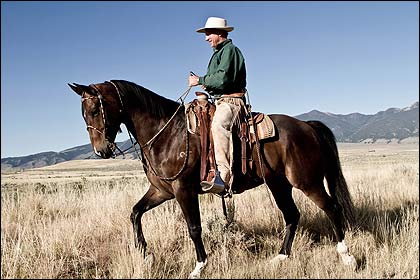
The (Real) Horse Whisperer
Buck reveals what horses teach humans
by Camilla Mortensen
 |
BUCK: Documentary. PG. Director, Cindy Meehl. Producer, Julie Goldman. Editor, Toby Shimin. Cinematographers, Guy Mossman, Luke Geissbühler. Music, David Robbins. Starring Buck Brannaman, Robert Redford. Four and a half stars.
Buck, the movie, lopes along at the same quiet pace its subject, Dan “Buck” Brannaman, might take putting a green horse through its paces on the first ride. It’s a documentary about a cowboy who epitomizes what a cowboy should be, and a movie as much about people as it is about horses.
Tall, rangy Brannaman trains horses in the tradition of the horse whisperers — so called because their quiet ways of gentling horses mystified those who were used to horses being beaten and having their spirits broken in order to be ridden.
The contemporary idea of these mysterious animal trainers was popularized by Robert Redford’s 1998 film, The Horse Whisperer, based on the book by Nicholas Evans. Redford makes an appearance in Buck, where he talks about meeting this quiet cowboy and at first laughing at what he took to be Buck’s cowboy costume. Brannaman in turn deadpans the story of his own horse outperforming the Hollywood stunt horse slated to play in the film.
Buck takes us across the country alongside Brannaman, with stunning scenery from North Carolina to Montana. It takes the viewers on a narrative journey as well, moving from a film that seems to be about horse training to one about the things animals teach people. Brannaman tells watchers at his starting clinics for colts, that he doesn’t help people with horse problems: “It’s horses with people problems,” he explains. He doesn’t break horses, he “starts” them, using an understanding of the animal’s perspective that comes from the violence that was in his own life.
Brannaman learned his training from Oregon’s own Tom Dorrance and from Dorrance’s student Ray Hunt, who first popularized this “natural horsemanship” type of training. But Brannaman learned to understand the horses, and their fears, not only from these earlier trainers, but also thanks to an abusive father who beat him and his brother until they were taken away by the local sheriff and put into foster care. Brannaman’s elderly foster mother, Betsy Shirley, steals a couple scenes, telling the audience drolly that, as a child, Brannaman evidenced no signs of early genius.
Interviews with those who have been helped, and whose horses have been helped, by Brannaman’s work help explain his life on the road going from one clinic to another. The movie depicts Buck as a loving farther, unlike his own parent, but one that is also distant much of the year.
The violence of Brannaman’s early childhood is rendered quietly visceral through documentary footage of horses being roped and abused. One of the most heart-wrenching scenes in the film involves a horse that even Buck can’t fix. “Humans failed that horse,” he says.
Brannaman’s dry wit and sometimes self-deprecating air keep the film from the easy pathos into which a tale of an abused boy growing into a good man might descend. Explaining the relationship between horse and rider, he says, “It’s a trust thing … It’s a little bit like when you are dating — the last two minutes of the first date can be a real dealbreaker.” Brannaman’s ability to work with and ride horses seems like magic — voodoo stuff one participant calls it — but the film makes clear that, like a relationship, it gets down to hard work and understanding.
Buck won the U.S. Documentary Competition Audience Award at the 2011 Sundance Film Festival and word is that critics are eyeing it for an Oscar.
Buck plays through Thursday, Aug. 11, at the Bijou; info and times at www.bijou-cinemas.com